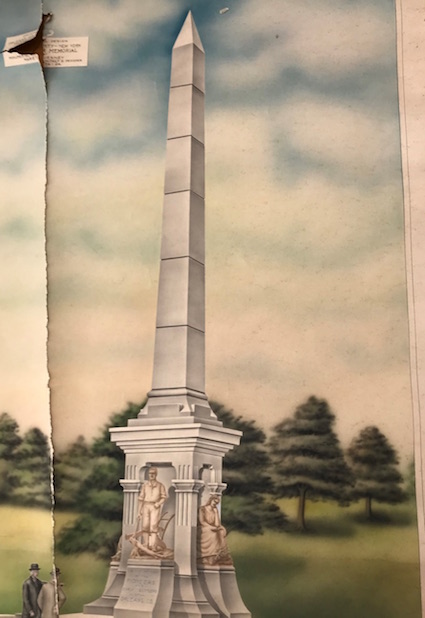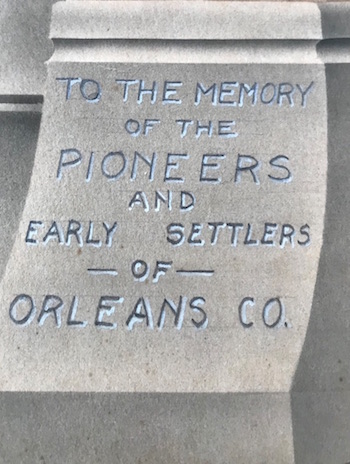Impressive monument for pioneers in Orleans County never came to fruition
40-foot-high obelisk was planned for Courthouse Square
By Catherine Cooper, Orleans County Historian
“Illuminating Orleans” – Volume 1, No. 9

The Orleans County Pioneer Association was formed in 1859 “to preserve and perpetuate the remembrance of interesting facts connected with the early history of the settlement of Orleans County” and to pay tribute to the settlers who could ”recollect when here was nothing but a dark, unbroken wilderness.”
In June 1910, in anticipation of the upcoming centenary of the original settlement of the county, the Pioneer Association appointed a committee to take charge of the formation of the Orleans County Pioneers Monument Association which would be charged to raise $3,000 to erect a suitable monument in memory of the pioneers.
At a special meeting of the Orleans County Pioneer Association held on Feb. 23, 1911, President John Bidleman was authorized to get approval from the Legislature to erect the monument on the County Courthouse Square. He was also instructed to “secure assistants in the towns to circulate subscription papers among the families of the pioneers for funding the monument.”
The Medina Daily Journal of July 10, 1911 reports the appointment of the following as committee members of the Orleans County Pioneers’ Monument Association: President: Dr. R.W. Bamber, Two Bridges, Supervisor: Daniel D. Daum, Clarendon, Vice-President: Dr. John A. Hartman, Albion, Secretary: Harry E. Colburn, Albion.
It was noted that Dr. Bamber would try to raise $10,000 for the project.
On July 20, 1911, a committee was formed to obtain designs and an estimate of costs. Members included Irving L’Hommedieu of Medina, Lafayette H. Beach of Albion, Jacob Tillis of Gaines, Harry Wellman of Kendall and Dr. W.R. Bamber of Carlton.
A meeting was held on November 23, 1911 to inspect the designs. “Several prominent monument manufacturing concerns and some noted sculptors appeared before the committee and presented miniature models” (Medina Tribune). The cost of the models presented ranged from $3,000 to $15,000. It was reported that the committee hoped to secure a design for less than $10,000.

However, the project did not come to fruition after all. There is no record available of how much money was actually gathered. And, it would seem that there was some dissension. The Medina Daily Journal of June 17, 1912 “decried the action of the Pioneer Association in opposing the Ridge Road Centennial” as “unfortunate.” The Centennial, planned for 1913, was to honor the State’s appropriation in 1813 of $5,000 for the improvements which made it “a great military and emigration highway.”
In actual fact, the two publications which chronicle the Association (Pioneer History of Orleans County, New York, by Arad Thomas and Record of the Orleans County Pioneer Association,) are more evocative than any monument, for they contain compelling first-hand accounts of the settlers’ early trials and tribulations.
They may be accessed at your favorite library or online at the following links: Pioneer History of Orleans County, New York (click here) and the Record of the Orleans County Pioneer Association (click here).









































































